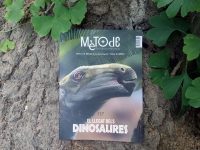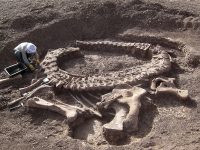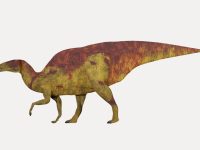Dinosaurs in Spain and the rural environment
Research at the service of territorial development
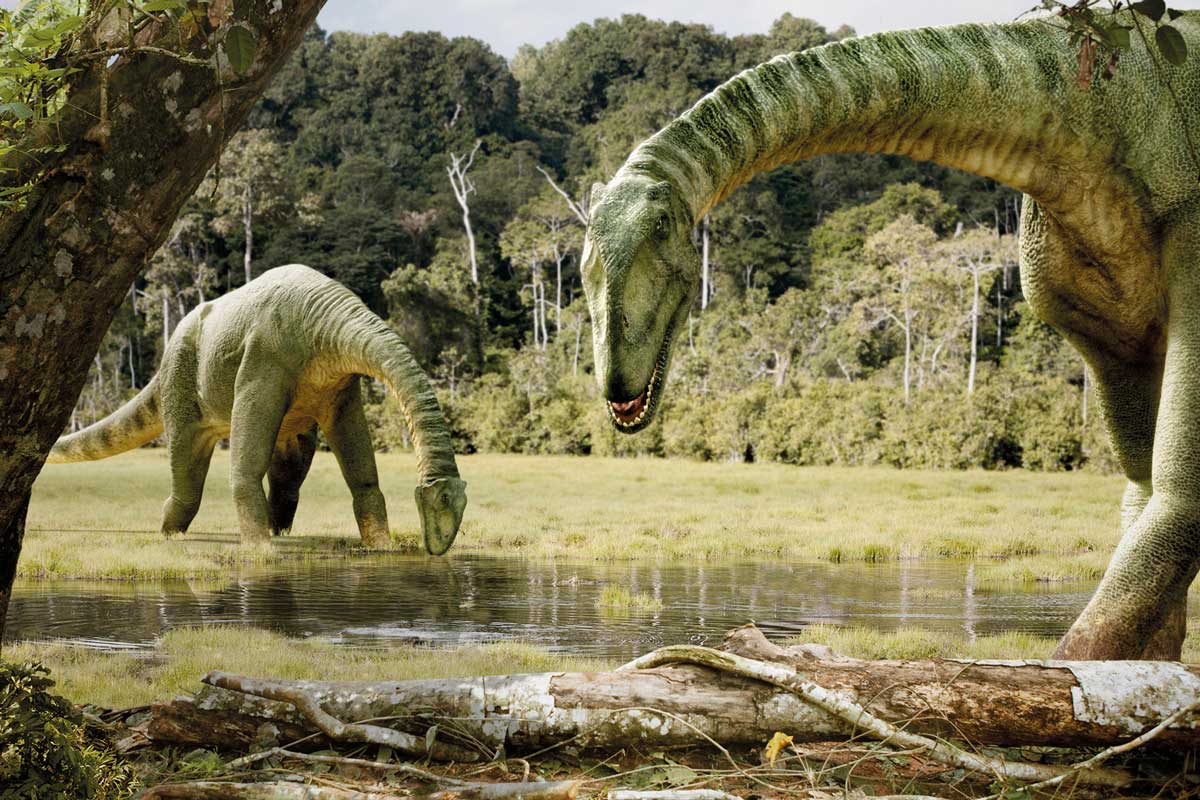
In some rural areas, the impact of palaeontological research on dinosaurs and their geological environment is a very important scientific, cultural, and socio-economic catalyst. The proliferation of places that showcase these types of resources (such as palaeontological parks, museums, geoparks, interpretation centres, and guided routes, etc.) has multiplied in recent years, and they are visited by thousands of people interested in the history of life on Earth. Spain is one of the most representative countries in the world regarding the use of dinosaurs as a factor for territorial development in rural areas. In some cases, such as in the province of Teruel, this is enhanced by the permanent presence of specialists who carry out their research in the immediate environment from which the fossils originate.
Keywords: palaeontology, Jurassic, Cretaceous, depopulation, geotourism.
Introduction: An important area for palaeontology
The year 2022 marked a century and a half since the first scientific documentation of dinosaurs in Spain (Vilanova & Piera, 1872). Some fossils from Utrillas (Teruel) and Morella (Castellon) are part of this history: the starting point for numerous palaeontological discoveries, some of which have provided new dinosaurs of reference for world science. Spain has a very representative fossil record of the evolution of the «terrible lizards» from the Upper Jurassic to the Upper Cretaceous periods (between 150 and 66 million years ago). A great number and variety of dinosaur species have been recorded from this long geological period which lasted more than 80 million years, making Spain the most important area in Europe for the study of these creatures.
The first of the new dinosaurs defined in Spain was the sauropod Aragosaurus ischiaticus (Sanz et al., 1987). Since then, more than 30 new non-avian dinosaurs have been defined based on Spanish fossils. Some of the most representative Jurassic species are the sauropods Turiasaurus riodevensis (Royo-Torres et al., 2006) and Losillasaurus giganteus (Casanovas-Cladellas et al., 2001). Specimens from the Lower Cretaceous, specifically from a geological stage called the Barremian (which is about 127 million years old), include the ornithopods Morelladon beltrani (Gasulla et al., 2015) and Iguanodon galvensis (Verdú et al., 2015), the sauropods Europatitan eastwoodi (Torcida Fernández-Baldor et al., 2017) and Tastavinsaurus sanzi (Canudo et al., 2008), and the theropod Concavenator corcovatus (Ortega et al., 2010), among others. Particularly important in the Albian period (from about 110 million years ago) are the ornithopod Proa valdearinnoensis (McDonald et al., 2012) and the ankylosaur Europelta carbonensis (Kirkland et al., 2013). For the Upper Cretaceous period, the sauropods Lohuecotitan pandafilandi (Díez Díaz et al., 2016) and Abditosaurus kuehnei (Vila et al., 2022) are representative. However, in addition to new taxa, dinosaur fossils of various types (mainly bones, eggs, and tracks) have been excavated at hundreds of sites in 10 autonomous communities in Spain, most of which are located in heavily depopulated provinces and regions (Cobos et al., 2020).
In this context, dinosaurs are one of Spain’s great scientific and tourist resources, and their fossils are a useful tool and an opportunity to strengthen research and the transfer and application of knowledge to the scientific culture of society. Indeed, several projects are currently being developed in Spain for the study, conservation, and dissemination of «dinosaur resources». In general, these initiatives are carried out close to the sites of origin and, in some cases, become a socio-economic driving force in economically and demographically depressed rural areas.
Dinosaurs as a geotourism resource in depopulated Spain
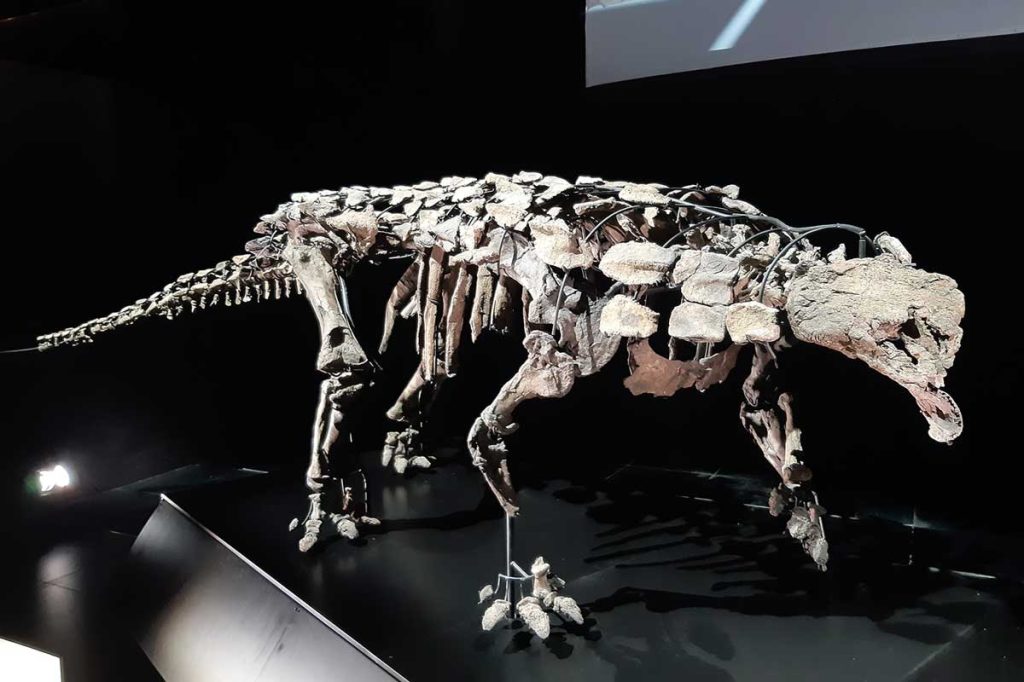
Original skeleton of the ankylosaur Europelta carbonensis from the Albian period in Ariño (Teruel) and exhibited in Dinópolis. It is one of the more than 30 non-avian dinosaurs described to date in Spain. / Fundación Dinópolis
Broadly speaking, dinosaur ichnite (footprint) sites have been excavated, adapted, and equipped in the Spanish regions where these resources are most important. Palaeontological centres of various sizes and types have also been set up in nearby towns. The most important of these are located in different Autonomous Communities: in Aragon, the Dinópolis Palaeontological Park in Teruel and the Dinosaur Museum in Arén (Huesca) stand out; in the Principality of Asturias, there is the Jurassic Museum of Asturias; Castile and León has the Dinosaur Museum in Salas de los Infantes (Burgos) and the routes around the ichnite sites in Burgos and Soria; in Castilla-La Mancha, there is the Museum of Palaeontology (MUPA) in Cuenca; in La Rioja, the Palaeontological Centres of Enciso and Igea (closely linked to the museums of the ichnite sites) are important; the Valencian Community has the Palaeontological Museum and Classroom in Alpuente (Valencia) and the Temps de Dinosaures Museum in Morella (Castellon); and finally, in Catalonia, there are several local exhibition centres in the provinces of Barcelona and Lleida.
To these centres we can add some more general museums with interesting dinosaur content, such as the Museum of the Catalan Institute of Palaeontology Miquel Crusafont in Sabadell, the Spanish National Museum of Natural Sciences (MNCN-CSIC) in Madrid, the Natural Science Museums of Álava and Valencia, and those of the Universities of Valencia and Zaragoza, among others (Alcalá et al., 2018).
A brief analysis of this relationship shows that most of the site-related centres or museums are located in the depopulated rural areas of Spain. According to the definition in Article 3 of Law 45/2007, of 13 December, on Sustainable Rural Development, the rural environment is «the geographical area formed by the aggregation of municipalities or smaller local entities defined by the competent administrations as having a population of less than 30,000 inhabitants and a density of less than 100 inhabitants per km2».

In Spain, palaeontological centres of various sizes have been set up in towns associated with fossils, such as the Alpuente Palaeontological Museum in the Valencian region of Los Serranos (shown in the image). / Alpuente Palaeontological Museum
Some of the geographical areas that meet these criteria and are also rich in dinosaur fossils are in Aragón, Castilla-La Mancha, Castile and León, Catalonia, Valencia, and La Rioja. However, the dinosaur richness of the provinces of Cuenca, Soria, and Teruel stand out in particular. Together, they cover an area of 42,257.87 km2 in the Spanish interior, even though their cumulative population is estimated at only around 420,000 inhabitants, according to the 2021 data from the Spanish National Statistics Institute. These figures result in a population density of just over 10 inhabitants/km2, compared with the Spanish average of 95. For these, and other reasons, the three provinces are recognised by both the European Union and the Kingdom of Spain as «sparsely populated areas» in southern Europe. The aim of this designation is to establish measures to reverse the process of depopulation, population ageing, and demographic and economic fragility.
However, the socio-economic synergies of dinosaur-oriented geotourism are only a small part of the solution. The local public administrations, counties, and/or autonomous communities of these three provinces have all been involved in dinosaur-related palaeotourism to varying degrees and on different scales.
Cuenca (Castilla-La Mancha)
In the province of Cuenca, the discoveries and palaeontological work at two sites of great scientific importance are particularly noteworthy: Las Hoyas and Lo Hueco. The first, from the Lower Cretaceous period and around 125 million years old, is located in the town of La Cierva. Las Hoyas is considered a site of exceptional preservation and among its many important palaeontological finds are the theropod dinosaurs Pelecanimimus polyodon (Pérez-Moreno et al., 1994) and Concavenator corcovatus (Ortega et al., 2010). In addition, several genera of avian dinosaurs from this site have also been described.
With regard to the Upper Cretaceous site of Lo Hueco, which is approximately 75 million years old and is located in the municipality of Fuentes, numerous fossils of sauropods – such as the titanosaur Lohuecotitan (Díez Díaz et al., 2016), theropods, and ornithopods (in some cases exceptionally complete and abundant), have been recovered.
The dissemination of the findings from these sites has been mainly carried out by the MUPA, the Palaeontological Museum of Castilla-La Mancha, located in the city of Cuenca. This museum has received more than 400,000 visitors in the seven years since it opened, despite being located in a city with a population of around 54,000. It has also received a high level of internal tourism because of its good rail and road access from major cities such as Madrid and Valencia. The Las Hoyas collection consists of more than 20,000 pieces, while the Lo Hueco collection contains more than 12,000 artefacts. This museum also exhibits and conserves dinosaur fossils from other towns in Cuenca and other provinces in the autonomous community (such as Guadalajara). In addition, two more exhibition centres can be visited on the Route of the Dinosaurs of Cuenca: one in Cañada del Hoyo, in the site of Las Hoyas, and another in Fuentes, in the site of Lo Hueco.
Soria (Castile and León)

The Fuentesalvo site is part of the Route of the Ichnites of Tierras Altas, Soria (Spain). Some of the sites on this route are a good example of palaeontological conservation and dissemination in very sparsely populated areas. / Fundación Dinópolis
The best known sites in Soria are those with ichnites from dinosaurs and other Mesozoic vertebrates. They belong to the Berriasian period (the first geological stage of the Cretaceous period, almost 145 million years ago). New fossil footprints have been described at these sites, such as those of Kalohipus bretunensis (Fuentes-Vidarte & Meijide-Calvo, 1998). In some of the sites, museographic activities have been carried out in situ and form part of the Route of the Ichnites of Tierras Altas, Soria. Among these, the sites of Serrantes, Fuentesalvo, Salgar de Sillas, Fuente Lacorte-El Frontal, and Los Tormos stand out for their scientific importance. Some of these sites are signposted and are good examples of palaeontological conservation and dissemination in very sparsely populated areas. In addition, in the town of San Pedro Manrique, with a population of only around 600, there is an open-air park dedicated to dinosaur footprints, with educational panels, replicas, and games.
Focusing only on the bones, two new Lower Cretaceous dinosaurs have been defined in Soria: the sauropod Soriatitan golmayensis (Royo-Torres et al., 2017) and the ornithopod Magnamanus soriaensis (Fuentes-Vidarte et al., 2016). Many of the fossils from Soria are deposited in the Numantine Museum in the provincial capital.
Teruel (Aragón)
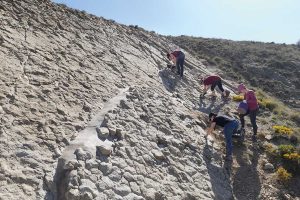
Palaeontological and museum adaptation work on a dinosaur footprint site in Miravete de la Sierra (Teruel, Spain). This village is seriously depopulated, which led to it being the subject of an advertising campaign in 2008 under the slogan «The village where nothing ever happens». / Fundación Dinópolis
Since the first historical references in the municipality of Utrillas by Vilanova y Piera (1872), dinosaur fossils have been documented in around 45 municipalities in the province of Teruel. However, after these discoveries, Teruel had to wait several decades, until well into the 20th century, for new dinosaur fossils to be found. The most important were those from the municipality of Galve, where in 1987 the first Spanish dinosaur new to science, Aragosaurus, was defined (Sanz et al., 1987). Thus, the «Aragon lizard» became the first of more than 30 non-avian dinosaurs first defined in Spain (10 of which came from Teruel). The 1990s saw an increase in the amount of research carried out in the province by various institutions. Of note, in 1998, an event of great importance took place that undoubtedly distinguished it from other dinosaur initiatives carried out in Spain. The Regional Government of Aragon created the Fundación Conjunto Paleontológico de Teruel, a scientific institution inextricably linked to the Dinópolis project. The aim of this initiative was to give an economic and scientific boost to the province where most of Aragon’s dinosaur fossils were found. The Foundation’s objectives focus on the study, conservation, and dissemination of the palaeontological heritage of the area. Since its opening in 1998, the number of dinosaur finds in the province has increased exponentially. In fact, scientific teams from the Foundation and other institutions defined several new dinosaurs, including the sauropods Turiasaurus (Royo-Torres et al., 2006) – the largest dinosaur in Europe – and Tastavinsaurus (Canudo et al., 2008), the ankylosaur Europelta (Kirkland et al., 2013), and the ornithopods Proa (McDonald et al., 2012) and Iguanodon galvensis (Verdú et al., 2015), among others. Teruel also has some dinosaur ichnites that were new to science, such as those of Iberosauripus grandis (Cobos et al., 2014). To date, around 60,000 fossils have been deposited in the Foundation’s collections at the Aragon Museum of Palaeontology, and hundreds of new dinosaur sites ranging from the Upper Jurassic to the Upper Cretaceous periods have been discovered.
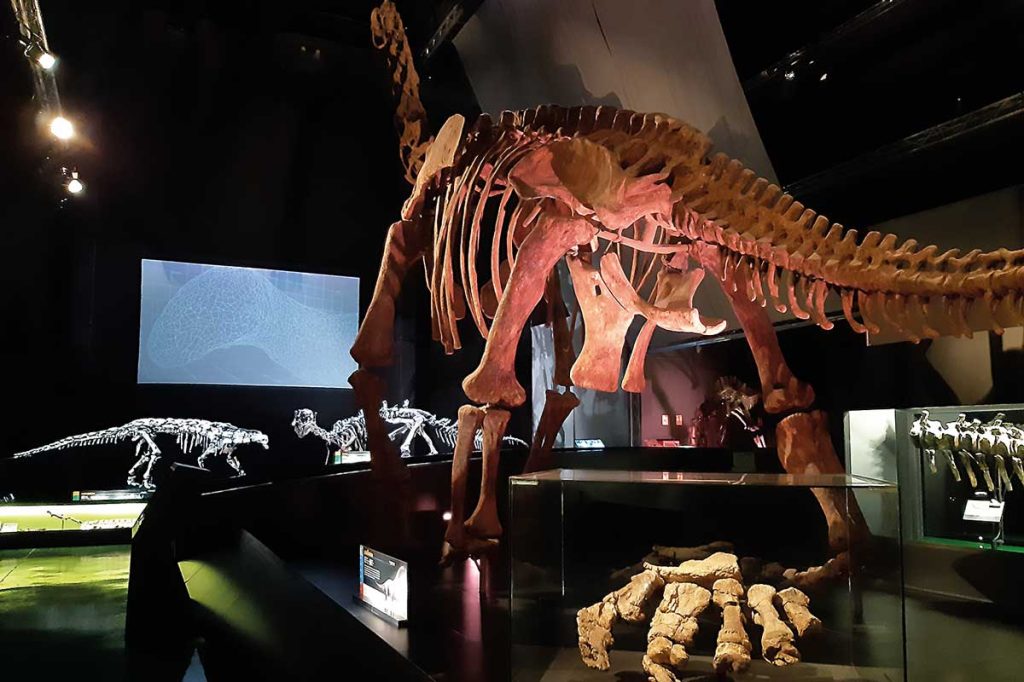
Dinosaur Hall at the Dinópolis Palaeontological Museum in the city of Teruel (Spain). The museum is part of the largest complex in Europe dedicated to the dissemination of our knowledge of the history of life on Earth. / Fundación Dinópolis
With all these resources, scientifically supported by the Foundation’s research work, the Dinópolis Palaeontological Park is the main scientific and tourist offering of the province of Teruel. Located in the capital city of Teruel, the park houses a large palaeontological museum extending around 10,000 m2, the largest complex in Europe dedicated to the history of life on Earth, as well as numerous attractions mainly aimed at recreational visits. To this must be added the various museographic sections developed in several satellite centres scattered throughout the province (Peñarroya de Tastavins, Galve, Rubielos de Mora, Castellote, Albarracín, Riodeva, and Ariño), where thematic exhibitions on local palaeontology are presented and where fossils or replicas of dinosaurs are displayed. Since 2001, the year of the inauguration of the Dinópolis headquarters in the city of Teruel, the Dinópolis centres combined have been visited by more than 3,500,000 people (an average of 160,000 per year), all in a province with only 135,000 inhabitants (about 9 per km2). Furthermore, the capital of the region, Teruel, has a population of around 35,000 people, while some of the other seven municipalities with Dinópolis centres have barely more than 100 registered inhabitants, in areas with little more than 2 inhabitants per km2. Thus, over the last two decades, Dinópolis has become one of the most important scientific and tourist motors in the province of Teruel, incorporating palaeontology in general, and dinosaurs in particular, into the leisure activities of millions of people.
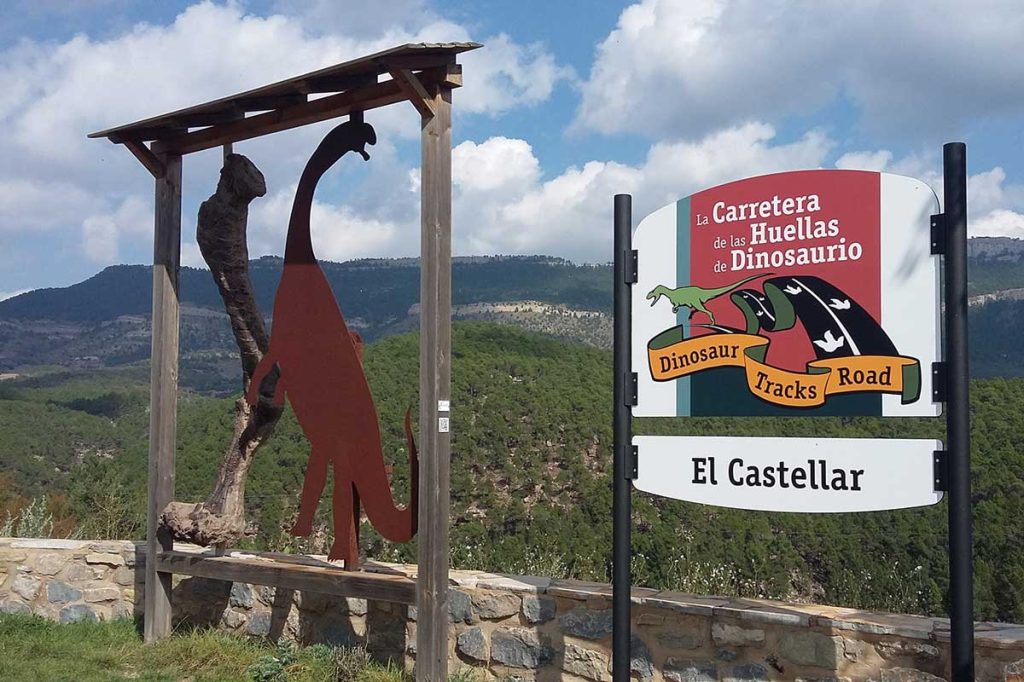
One of the stops on the Dinopaseo through El Castellar (Teruel, Spain), included in the Dinosaur Tracks Road. This municipality, with barely 60 inhabitants, has also developed the Dinosaur Route, which includes four stops adapted as on-site museums. / Fundación Dinópolis
There are also other initiatives in Teruel that complement the palaeontological offering of the province. In particular, the Comunidad de Teruel region has set out to make palaeontology its flagship tourist activity, through the DinoExperience brand. The Giant’s Route, which links the famous frog fossil sites of Libros and the dinosaurs of Riodeva, and In the Footprints of the Dinosaur, with the ichnite sites of Ababuj, Aguilar del Alfambra, and Galve, are the most important proposals in the area. In addition to the Dinópolis site, the latter also hosts the Municipal Museum and two sites with footprints as well as some reconstructions of local dinosaurs. Finally, the Dinosaur Tracks Road links Galve with El Castellar, among other villages. In collaboration with four local museums, this municipality, with just 60 inhabitants, has created the Dinopaseo ('Dinowalk') and the Dinosaur Route, themed walks about the local dinosaurs. One of these is the only site in Europe where the original fossils can be observed in situ (Cobos et al., 2020).
Conclusions: An opportunity for rural areas
Dinosaurs are one of Spain’s great scientific and tourist attraction resources, and their fossils represent a useful tool and an opportunity to strengthen palaeontological research and promote the socio-economic development of the rural regions where they are found, which are usually impoverished and depopulated. In addition, the «terrible lizards» promote nature and cultural tourism, which in turn strengthens the scientific culture of society, using various tools for the transfer of knowledge.
In this article we have seen how dinosaur fossils and the dissemination of their Mesozoic environment have the potential to contribute significantly to the development of depopulated areas in a large part of Spain. The impact of palaeontological research on dinosaurs and their geological context is a very important scientific, cultural, and socio-economic catalyst in some rural areas. The examples discussed here, from some of the most depopulated provinces in southern Europe, such as Cuenca, Soria, and Teruel, are representative of this. In some cases, such as that of Teruel, specific research has been carried out on the positive socio-economic impact of dinosaur-related geotourism in highly depopulated areas (see references, for example, in Cobos et al., 2020). These actions have been supported by the permanent presence of a scientific foundation for the past 25 years. Teruel is therefore unique in the fact that specialists in research, conservation, and educational dissemination carry out their work in the immediate environment from which the fossils originate. Extending this Aragonese model to a national level would allow us to boost R&D&I in dinosaur palaeontology in Spain and thus, become an international benchmark for this field.
References
Alcalá, L., Cobos, A., & Royo-Torres, R. (2018). Dinosaurios de la Península Ibérica. Revista PH, 94, 116–153. https://doi.org/10.33349/2018.0.4145
Canudo, J. I., Royo-Torres, R., & Cuenca-Becos, G. (2008). A new sauropod Tastavinsaurus sanzi gen. et sp. nov. from the Early Cretaceous (Aptian) of Spain. Journal of Vertebrate Paleontology, 28(3), 712–731. https://doi.org/10.1671/0272-4634(2008)28[712:ANSTSG]2.0.CO;2
Casanovas-Cladellas, M. L., Santafe, J. V., & Sanz, J. L. (2001). Losillasaurus giganteus, un nuevo saurópodo del Tránsito Jurásico-Cretácico de la cuenca de ‘‘Los Serranos’’ (Valencia, España). Paleontologia i Evolució, 32–33, 99–122.
Cobos, A., Alcalá, L., & Royo-Torres, R. (2020). The Dinosaur Route in El Castellar (Teruel, Spain): Palaeontology as a factor of territorial development and scientific education in a sparsely inhabited area. Geoheritage, 12, 52. https://doi.org/10.1007/s12371-020-00474-3
Cobos, A., Lockley, M. G., Gascó, F., Royo-Torres, R., & Alcalá, L. (2014). Megatheropods as apex predators in the typically Jurassic ecosystems of the Villar del Arzobispo Formation (Iberian Range, Spain). Palaeogeography, Palaeoclimatology, Palaeoecology, 399, 31–41. https://doi.org/10.1016/j.palaeo.2014.02.008
Díez Díaz, V., Mocho, P., Páramo, A., Escaso, F., Marcos-Fernández, F., Sanz, J. L., & Ortega, F. (2016). A new titanosaur (Dinosauria, Sauropoda) from the Upper Cretaceous of Lo Hueco (Cuenca, Spain). Cretaceous Research, 68, 49–60. https://doi.org/10.1016/j.cretres.2016.08.001
Fuentes-Vidarte, C., & Meijide-Calvo, M. (1998). Icnitas de dinosaurios terópodos en el Weald de Soria (España). Nuevo icnogénero Kalohipus. Estudios Geológicos, 54, 147–152. https://doi.org/10.3989/egeol.98543-4213
Fuentes-Vidarte, C., Meijide-Calvo, M., Meijide-Fuentes, F., & Meijide-Fuentes, M. (2016). Un nuevo dinosaurio estiracosterno (Ornithopoda: Ankylopollexia) del Cretácico Inferior de España. Spanish Journal of Palaeontology, 31(2), 407-446. https://doi.org/10.7203/sjp.31.2.17163
Gasulla, J. M., Escaso, F., Narváez, I., Ortega, F., & Sanz, J. L. (2015). A New sail-backed styracosternan (Dinosauria: Ornithopoda) from the Early Cretaceous of Morella, Spain». PLOS ONE, 10(12), e0144167. https://doi.org/10.1371/journal.pone.0144167
Kirkland, J. I., Alcalá, L., Loewen, M. A, Espílez, E., Mampel, L., & Wiersma, J. P. (2013). The basal nodosaurid ankylosaur Europelta carbonensis n. gen., n. sp. from the Lower Cretaceous (Lower Albian) Escucha Formation of Northeastern Spain. PLOS ONE, 8(12), e80405. https://doi.org/10.1371/journal.pone.0080405
McDonald, A. T., Espílez, E., Mampel, L., Kirkland, J. I., & Alcalá, L. (2012). An unusual new basal iguanodont (Dinosauria: Ornithopoda) from the Lower Cretaceous of Teruel, Spain. Zootaxa, 3595, 61–76. https://doi.org/10.11646/zootaxa.3595.1.3
Ortega, F., Escaso, F., & Sanz, J. L. (2010). A bizarre, humped Carcharodontosauria (Theropoda) from the Lower Cretaceous of Spain. Nature, 467(7312), 203–206. https://doi.org/10.1038/nature09181
Perez-Moreno, B. P., Sanz, J. L., Buscalioni, A. D., Moratalla, J. J., Ortega, F., & Raskin-Gutman, D. (1994). A unique multitoothed ornithomimosaur from the Lower Cretaceous of Spain. Nature, 370, 363–367. https://doi.org/10.1038/370363a0
Royo-Torres, R., Cobos, A., & Alcalá, L. (2006). A giant European dinosaur and a new sauropod clade. Science, 314, 1925–1927. https://doi.org/10.1126/science.1132885
Royo-Torres, R., Fuentes, C., Meijide-Fuentes, F., & Meijide-Fuentes, M. (2017). A new Brachiosauridae Sauropod dinosaur from the lower Cretaceous of Europe (Soria Province, Spain). Cretaceous Research, 80, 38–55. https://doi.org/10.1016/j.cretres.2017.08.012
Sanz, J. L., Buscalioni, A. D., Casanovas, M. L., & Santafé, J. V. (1987). Dinosaurios del Cretácico Inferior de Galve (Teruel, España). Estudios Geológicos, 43(Extra), 45–64. https://doi.org/10.3989/egeol.8743Extra625
Torcida Fernández-Baldor, F., Canudo, J. I., Huerta, P., Moreno-Azanza, M., & Montero, D. (2017). Europatitan eastwoodi, a new sauropod from the lower Cretaceous of Iberia in the initial radiation of somphospondylans in Laurasia. PeerJ, 5, e3409. https://doi.org/10.7717/peerj.3409
Verdú, F. J., Royo-Torres, R., Cobos, A., & Alcalá. L. (2015). Perinates of a new species of Iguanodon (Ornithischia: Ornithopoda) from the lower Barremian of Galve (Teruel, Spain). Cretaceous Research, 56, 250–264. https://doi.org/10.1016/j.cretres.2015.05.010
Vila, B., Sellés, A., Moreno-Azanza, M., Razzolini, N. L., Gil-Delgado, A., Canudo, J. I., & Galobart, À. (2022). A titanosaurian sauropod with Gondwanan affinities in the latest Cretaceous of Europe. Nature Ecology & Evolution, 6, 288–296. https://doi.org/10.1038/s41559-021-01651-5
Vilanova y Piera, J. (1872). Tercer período-Mesozoico. Idem Cretáceo. In J. Vilanova y Piera, Compendio de geología (pp. 471–483). Imprenta de Alejandro Gómez Fuentenebro.


